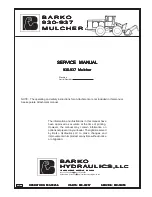
Pub# OM22-iScan EC-OM
6-7
C. Testing Electrode isolation
If continuity tests show no excessive resistance on any channel, yet erratic soil EC readings continue, or if
EC readings do not drop to
–1 when unit is out of the soil, it is possible that the channels are not isolated.
This could be the result of a pinched wiring cable, causing channels to short out. Or, one of the electrodes is
no longer insulated properly from the frame or adjacent electrodes.
1. Electrode isolation. The iScan electrodes have insulators installed between each electrode. If mud
builds up on the iScan module, the wet soil could bridge across an insulator and allow a signal pathway
between electrodes other than only through the field soil. To correct this, first identify which electrodes
are exhibiting continuity. (Note: if there is no wet soil buildup, the problem may be a pinched cable
—in
which case you may want to begin with Step 2 below)
2. If EC readings do not drop to
–1 when unit is not in the soil, and no wet soil bridging across insulators is
evident, the wires inside the EC signal cable may be shorting. Begin by ruling out any problem with the
V-Sense controller: disconnect signal cable from V-Sense controller
. If readings don’t drop to -1, the
problem is with the controller. If readings show -1 with the signal cable disconnected from the controller,
re-connect the signal cable into the controller. Then disconnect each terminal connector wire from each
electrode and keep terminal wire from contacting any metal
—wrap with electrical tape if needed. If
readings don’t drop to –1, the problem is with the wiring harness. If this is the case, replacement of the
wiring harness is needed. If readings do drop to -1 with all terminal wires disconnected and isolated, re-
insert the signal cable extension into the implement. The problem is with one or more of the electrodes.
Return to Step 1 above.
Test each electrode isolation by
checking resistance between each
of the electrodes. Any continuity
from one electrode to another is not
acceptable. Remove buildup of wet
soil, especially if it bridges across
insulators. It may be necessary to
remove electrode and clean
insulator, if problem persists.
Figure 4-4










































